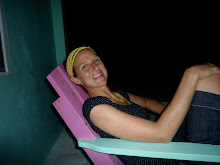I first met Mark-Elliot Lugo, Curator of the San Diego Public Library’s Visual Arts Program, in August while on my whirlwind thirty-six-in-thirty-six tour. It was day twelve, and I had barely entered the gallery when Lugo emerged from his office and welcomed me. He didn’t know who I was or why I was there—or that I’d post a review of the Pacific Beach/Taylor branch later that day on this blog—but generously gave me an overview of the gallery’s then-current exhibition. I have to assume he’s this welcoming and helpful to everyone who enters the gallery.
Last week, Lugo was kind enough to meet and talk with me again at the PB branch.
The job of curator seems a perfect fit for Lugo, but it wasn’t a job vacancy that he applied for. As a San Diego librarian, Lugo had watched the PB library being built in 1997 and thought it looked more like an art museum than a place simply for books. Lugo got the go-ahead to curate an art exhibition to mark the branch’s opening, and the program grew from there into something permanent, and unprecedented in our nation’s library systems. Initially, Lugo’s biggest fear was that the art wouldn’t be worthy of its exhibition space. “Really bad art could ruin this building,” he says.
The inaugural exhibition featured work by
Italo Scanga, a prolific artist who taught at my
alma mater and who also, incidentally, attended my husband’s
high school. Scanga died in 2001.
After 150 shows, Lugo’s fear of subpar art has gone unrealized. The program focuses on mid-career San Diego artists; Lugo has little desire in finding a young artist and giving them a platform that they perhaps have not yet earned. Instead, Lugo has exhibited artists like
Joyce Cutler Shaw, UCSD Medical School’s Artist-in-Residence; and
Harold Cohen, an artist who creates work with a self-designed computer program that seeks to capture a person’s creative instinct.
Lugo has also shown artists who’ve worked most of their life with little or no attention, and who haven’t sold a painting in years. When Lugo tells such an artist that they’re going to have a solo show, and that they should begin working on a body of work for the exhibition, he sees, “In despair, a renewed sense of vitality.” Some artists, he says, will sell more work through their one library solo show than in the rest of their life.
San Diego taxpayers will be happy to know the Visual Arts Program is self-sustaining. Art from each exhibition is available for purchase, and the library takes a percentage of each sale.
The exhibitions have garnered attention from the art world outside of San Diego. A few weeks ago, Janet Koplos, Guest Editor of
American Craft magazine, visited the gallery unannounced while in town for a museum talk. After viewing the
Jeff Irwin exhibition, she asked Leah Ollman, a nationally known art critic, to write an article on the show. It will be the Visual Arts Program’s first national review.
Not only does the Visual Arts Program give artists a platform to show their work, but it exposes San Diegans to really innovative art—people who, in Lugo’s words, may “just be coming in for an auto manual.”
The gallery’s
current exhibition of Beth King’s work runs through February 15, 2010.




